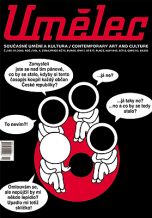| Umělec magazine 2003/3 >> GINA TORNATORE: OUTER AND INNER ACTIONS | List of all editions. | ||||||||||||
|
|||||||||||||
GINA TORNATORE: OUTER AND INNER ACTIONSUmělec magazine 2003/301.03.2003 Pavel Ondračka | review | en cs |
|||||||||||||
|
"The House of Lords of Kunštát in Brno gave young artist Gina Tornatore only her third solo exhibition (after Rome and Milan), where she proved that she is capable of joining intellectual discourse and an emotional, dreamlike logic within her short films. Since 1990, this Australian-born (1969) artist has studied, lived and worked in London, and her work has regularly shown up in collective exhibitions. It could be said that her job in the film industry has influenced her approach towards the medium of film more than the context and influences within the art scene.
There were two short movies in the two halls of The House of Lords. The projection Catch shows two male bodies rolling down a slightly inclined plane through a bleak courtyard. Like Bill Viola, Tornatore chose to use high-speed recording, which makes for an amazing slow projection. The bodies roll slowly close to the viewer and then recede, fading away before reappearing, all independent events whose repetition the viewer expects in this never-ending loop, but the film is made in such a way that, transfixed by the motion, nobody leaves at the first sign of repetition. The second movie, Outer and Inner Actions, is even more complex. Two attacks take place simultaneously. The first: a man sitting in an armchair watching TV is jumped by another man, who fiercely suffocates him with a plastic bag, and he eventually leaves the body motionless. The TV in this vision of cold-blooded murder transforms the scene, as a different but similar story unfolds on the screen. Victim two, a lonely barking dog, brings the two scenes together. In contrast to Catch, where the loop makes the story, this is a story with a beginning and an end. The obvious emphasis is on the position of the cameras, as the viewer is uncertain whether the room is being watched in secret or if somebody is recording the whole story. The hues of Gina Tornatore’s older work from the single shots on her web presentation would no doubt contribute to the gloomy atmosphere of the exposition. The artist’s keynote concentration on”disorders in the communication and co-existence of conflict, violence and sexuality in human relations” come to life in her work Giallo (1999), the story of an encounter, love, alienation, and murder. Gina Tornatore gradually realized her ambition to concentrate the story of a full-length film into a precisely composed story transformed into a frieze of life and death. In the commentary to the film Dead Finks Don’t Talk (2002) the artist mentions an “action which creates and emphasizes anxiety,” but at the same time she documents this anxiety in the movements, in the language of gestures, the relationships of the characters. She uses a documentary, “sociopolitical” interest in gestures to rid her expressions of possibly personal aspects. Gina Tornatore mingles naturally within a certain art environment and communicates in a language considered relevant. Because this task is one defined by our time, on the one hand it can feel personal, sometimes even like a disquieting preoccupation; on the other hand this is a concept she is using to compose her films into a monumental frieze. The artist herself moves on the time surface of the film, but for it to reach the spectator, it takes some time of personal immersion in the action. Her relatively young age justifies her leaning on the heavyweights of video art. But to set herself free from these influences, in recent years she has worked to break her expression up into independent moments, which are not fragments at all, but sentences contained with a larger work in progress. "
01.03.2003
Recommended articles
|
|||||||||||||
|
04.02.2020 10:17
Letošní 50. ročník Art Basel přilákal celkem 93 000 návštěvníků a sběratelů z 80 zemí světa. 290 prémiových galerií představilo umělecká díla od počátku 20. století až po současnost. Hlavní sektor přehlídky, tradičně v prvním patře výstavního prostoru, představil 232 předních galerií z celého světa nabízející umění nejvyšší kvality. Veletrh ukázal vzestupný trend prodeje prostřednictvím galerií jak soukromým sbírkám, tak i institucím. Kromě hlavního veletrhu stály za návštěvu i ty přidružené: Volta, Liste a Photo Basel, k tomu doprovodné programy a výstavy v místních institucích, které kvalitou daleko přesahují hranice města tj. Kunsthalle Basel, Kunstmuseum, Tinguely muzeum nebo Fondation Beyeler.
|

































 New book by I.M.Jirous in English at our online bookshop.
New book by I.M.Jirous in English at our online bookshop.
Comments
There are currently no comments.Add new comment